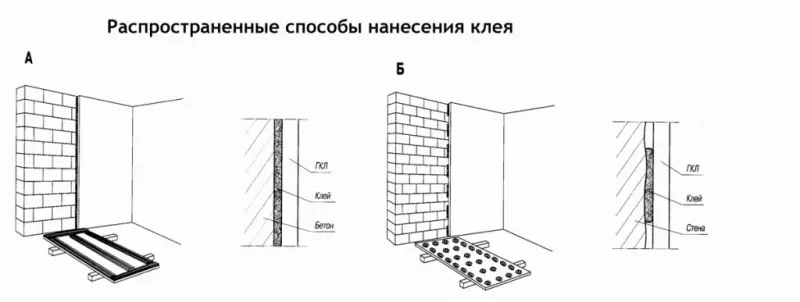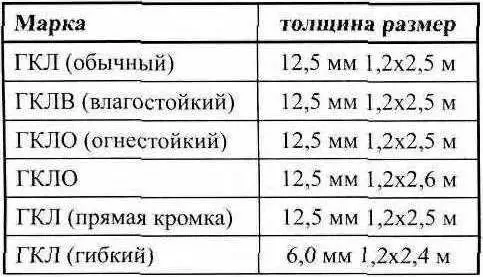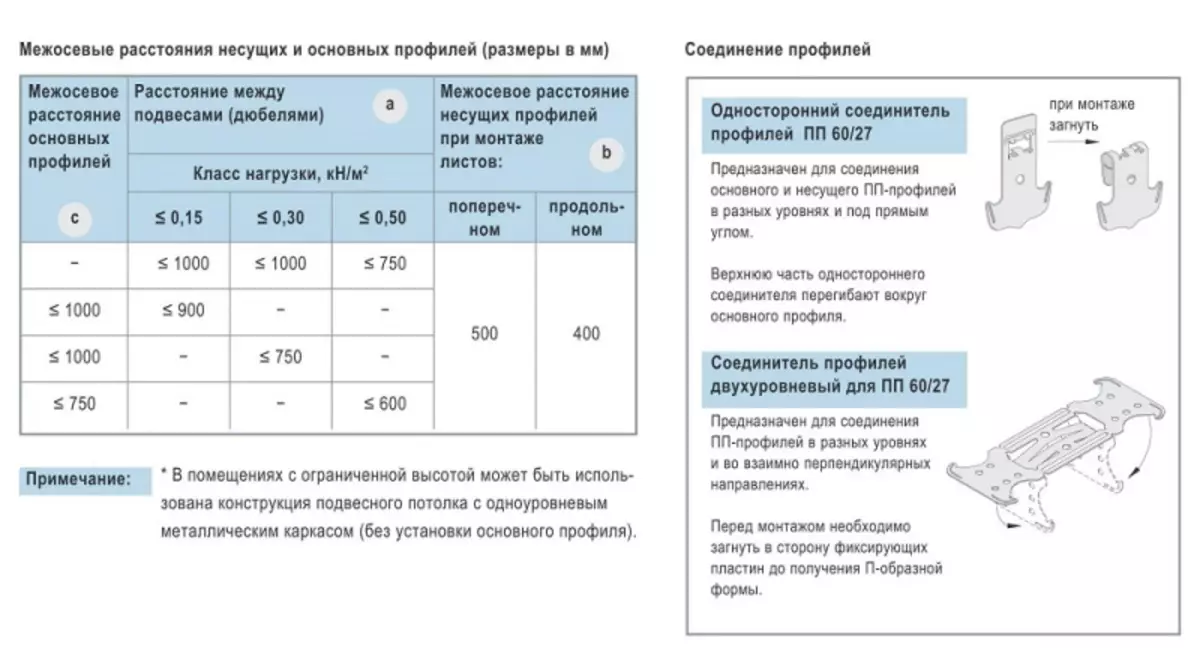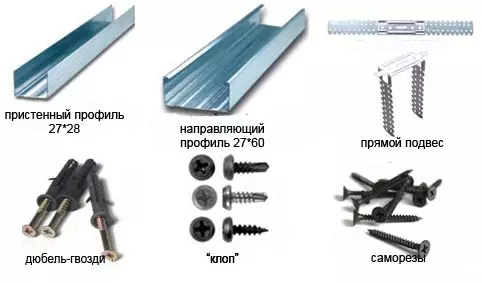When using drywall for finishing walls and ceiling, creating partitions, it is necessary to produce the exact calculation of all materials.

Methods of alignment of walls by plasterboard: A - on the frame, b - with a bakery way.
After all, the GLC is a sheet material, and therefore it is better to accurately calculate its necessary amount, as well as the amount of all necessary additional consumables. But before calculating plasterboard, you must decide how to mount it.
There are two methods for fastening drywall on the walls and the ceiling, which should be known about to calculate how much material will be needed:
- Installation on a frame made of metal profiles or wooden bars.
- Installation using special glue adhesives.

Tool for working with plasterboard.
In the first case, do not forget to calculate the following additional materials:
- Metal Mon (CD), 27x60 mm, length 3 or 4 m;
- Metal PP (UD), 27x27 mm, length 3 or 4 m;
- Suspension straight (butterfly);
- dowels;
- Metal screws for fastening metal profiles;
- screws that are connected to the mounted frame;
- Cross connections (crabs). It is used to connect the CD in the places of their perpendicular intersection;
- Connecting brackets. Used in the case when it is necessary to connect a profile if the room has a length or width of more than 3 or 4 m.
When using the adhesive method of connection of the GLC, after the general finish metage is observed, the glue consumption can be calculated. Each bag is indicated by 1 kV glue. m. Walls. As a rule, one bag of glue should be enough for 5-7 square meters. m.
To find out the flow of the glue bags, the total area (OP) of the surface on which the imposition of HCL will be made, divide by 5 or 7. You can safely add 20-30% to the manufacturer's recommendations, and then it turns out the real amount of glue that goes to work.
Dimensions of plasterboard

Classification of drywall and standard sheets of sheets.
Standard GLC has dimensions of 2500x1200 mm. It has a thickness of 12 mm for the walls, for the ceiling - 9 mm. Accordingly, its area is 3 m². It should be noted that there are other GLCs:
- 3000x1200 mm;
- 2500х600 mm;
- 2000x1200 mm.
Article on the topic: Cozy balcony in the style of Provence: A good solution
For example, when after all the calculations, it turns out that it is necessary to separate part of the wall with a height of 2500 mm and a width of 450 mm, then you can take a non-standard sheet, and the size of 2500x600.
In order to calculate the number of standard GLCs, you must first calculate or measure the decoration area - walls or ceiling. The result obtained is divided into one sheet area. When calculating the area, it will be necessary to take a ride that occupies door and window openings. The resulting number should be rounded to the whole to the most side.
There is also a method for calculating the number of sheets according to the special formula:
N = (s1 / s2) x k
Where n is plasterboard sheets;
S1 - decoration area, m²
S2 - Square of one sheet of plasterboard, m²

The circuit of the inter-axis distance of carrier and main profiles for drywall.
k - correction coefficient. The room where the finish will be made, has smaller sizes, the more would be more. Depending on the area, there are three correction coefficients:
- up to 10 m², then k = 1.3;
- from 10 to 20 m², then k = 1.2;
- More than 20 m², then k = 1,1.
Calculation of the number of UD. Metal UD, or, as it is also called, starter, is used to fix CD to walls, floor or ceiling. The perimeter of the room is divided into the length of the standard profile (3 or 4 meters). For walls, it is calculated similarly and multiplied by 2 - because it is attached on the floor and ceiling. The resulting number is rounded up to the whole side.
Calculation of the number of CD profiles. To connect one sheet, three metal CDs will be needed. After the number of GLC sheets is calculated, it should be divided into 3 - as a result, CD consumption will be obtained. There is a simple way to calculate the number of walls and ceiling - the perimeter of the room is divided by 0.6 m - the step between profiles. From the result obtained should be between 1.
Article on the topic: Pictures for the children's room on the wall. Creative solutions
How many materials do you need to cover the ceiling? It should be noted that when applying drywall on the ceiling in a room, which has a length or width of more than 2.5 m, you need to calculate the additional number of CD profiles.
Direct suspensions (butterflies) and dowels
Butterflies that are used to fasten the CD profiles to the ceiling or walls are considered based on the fact that they are installed in increments of 60-80 cm. For one suspension, two dowels are followed with rapid installation scammers 6x60, 8x80 or 10x80. In addition, it is necessary to take into account that the UD attachments are used similar dowels of quick installation. You need three dowels on the pontamon.Self-tapping screws

Self-tapping screws for profiles
For fastening profile to straight butterflies, screws No. 1 are used, which you need at least 2 pcs. for each suspension. Also, these self-tapping screws are used to connect and fix UD and CDs, crosses (crabs) and connecting brackets. It is possible that 30-40 such tapes are needed on the drywall sheet.
For installation of one standard sheet, you need 50 screws for metal L = 25 mm. When buying self-tapping and dowels, it is necessary to take them with a reserve, as they may fall or will need to use more than calculated.
Connecting brackets and crusades
Connecting brackets are used to connect the CD in a straight line when the GLC is installed on the ceiling. If the room has a width or length less than 3 m, then the connecting brackets do not apply. If the room has a greater width or length, then:
N = (L / 0.4) - 1) x k
Where n is connecting brackets;
L - the length of the widest wall in the room;
k - correction coefficient.
Depending on the width of the room, the correction coefficient has a magnitude:
- 3-6 m, k = 1;
- 6-9 m, k = 2;
- 9-12 m, k = 3.
etc.
Cross compounds (crabs), which are used to connect CD profiles in the places of their perpendicular intersection, are calculated according to the drawn HCL mounting plan.
Article on the topic: wallpaper on the wall: photo in the interior, under the mural for the kitchen, what to choose, seamless in the house, phlizelin, fashionable with the effect of frescoes, video
It should be noted that due to the high price of connecting brackets and the crusades, they are rarely used. As a rule, the CD of the profile is connected by cutting the appropriate size and bending the side walls with a further connection with each other with the help of metal screws.

An example of calculating materials under the ceiling of plasterboard.
Example for users
How much is the material need to cover the ceiling? Suppose we need to see the walls of the room 4x5 m with a height of 3 m. Then the OP will be s = (4 x 2) + (5x2) x 3 = 54 sq. m. From this figure, take 7 square meters. m. - Area of two windows and doors. As a result, it turns out that it is necessary to separate 47 square meters. m wall. Next, the calculation of the GCC and consumables occurs:
- Standard sheets of plasterboard 2500x1200: 47/3 = 15.6, round up to 16.
- UD Profile: perimeter ((4x2 + 5x2) / 3 m long) x2 - (18/3) x 2 = 12 pcs.
- Cd. The best option will draw a plan for mounting drywall and already consider everything the required amount of profile. In our case, for the walls, it is calculated as follows: perimeter (4x2 + 5x2) / distance between profiles 0.6 m = 18 / 0.6 = 30 3 m.
- Additional CD. Equally the perimeter of the room ((4x2 + 5x2) / for a length of 3 - 18/3 = 6.
- Direct suspensions: on 1 three-meter is not 5 butterflies. Accordingly, 30 x 5 = 150.
- Dowels: direct suspensions 150 x 2 = 300 and for mounting UD 12 x 10 = 120. 500 dowels are obtained with a margin.
- Self-timers: direct suspensions 150 x 2 and for attachment additionally CD 30 x 4 = 120. It is better to buy 500 with a margin.
- Screws for drywall: Glk 16 x 50 Exemplary consumption per LGK = 800.
And remember that before calculating GLC and understand how much materials needed, you need to draw a mounting scheme. In this case, you will know how much material you will probably need.
